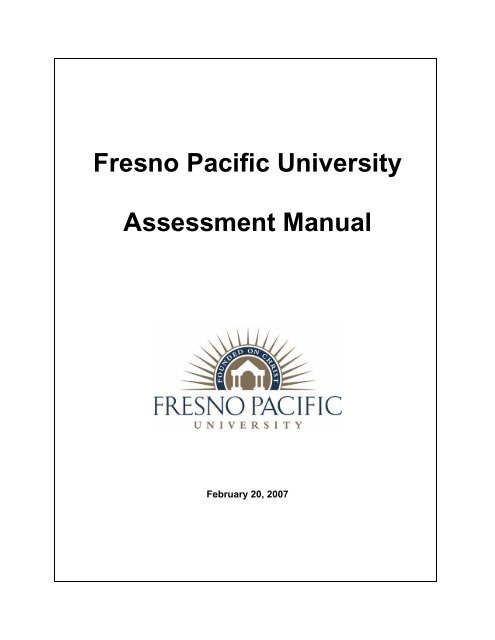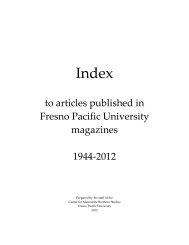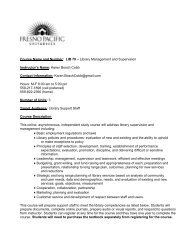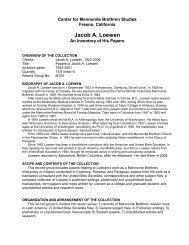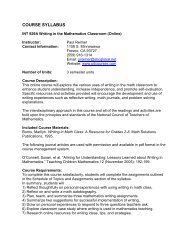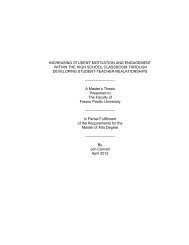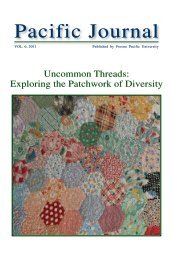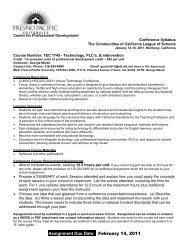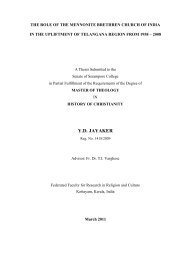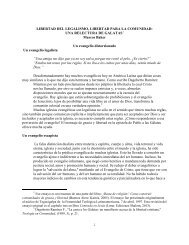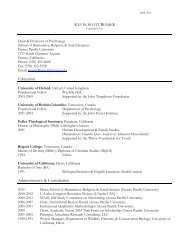Fresno Pacific University Assessment Manual
Fresno Pacific University Assessment Manual
Fresno Pacific University Assessment Manual
Create successful ePaper yourself
Turn your PDF publications into a flip-book with our unique Google optimized e-Paper software.
<strong>Fresno</strong> <strong>Pacific</strong> <strong>University</strong><br />
<strong>Assessment</strong> <strong>Manual</strong><br />
February 20, 2007
Table of Contents<br />
2<br />
<strong>Assessment</strong> <strong>Manual</strong><br />
Page<br />
3 <strong>Assessment</strong> Summary<br />
4 <strong>Assessment</strong> Background<br />
5 <strong>Assessment</strong> Approach and Process<br />
8 Summary: Developing an <strong>Assessment</strong> Plan<br />
8 <strong>University</strong> <strong>Assessment</strong> Committee<br />
9 <strong>Assessment</strong> Instruments and Methods Available to Assess Student<br />
Learning<br />
15 Appendix A – Mapping DSOs with Indicators of Learning<br />
16 Appendix B – Mapping DSO with Curriculum<br />
17 Appendix C – <strong>Assessment</strong> References<br />
Prepared by the <strong>University</strong> <strong>Assessment</strong> Committee
3<br />
<strong>Assessment</strong> <strong>Manual</strong><br />
<strong>Assessment</strong> Summary<br />
Purpose<br />
The purpose of assessment is to produce feedback to the program and school or administrative<br />
unit on the performance of its curriculum, learning process, and/or services, thereby allowing<br />
each unit to improve its programs. It is not an evaluation of individual students or of individual<br />
faculty or staff.<br />
Process<br />
The process to develop an assessment plan is the following:<br />
- Agree on your mission<br />
- Create goals for student outcomes and processes<br />
- Identify related activities for each goal<br />
- Brainstorm appropriate measures<br />
- Evaluate and select measures<br />
- Identify appropriate assessment methods<br />
- Develop a plan for collecting data<br />
- Prioritize goals<br />
- Set timeline, milestones<br />
- Implement assessment plan<br />
- Use data to improve processes<br />
- Communicate results<br />
Types of <strong>Assessment</strong> Measures<br />
<strong>Assessment</strong> measures include both direct and indirect means.<br />
Direct<br />
Indirect<br />
<strong>Assessment</strong> Measures <strong>Assessment</strong> Measures<br />
Capstone Course<br />
External Reviewers<br />
Course Embedded Student<br />
Surveying/Interviewing<br />
Tests/Exams<br />
Alumni<br />
Surveying/Interviewing<br />
Portfolio<br />
Employer<br />
Surveying/Interviewing<br />
Pre-test/Post-test<br />
Curriculum and Syllabus<br />
Analysis<br />
Thesis Evaluation<br />
Videotape or Audiotape<br />
Prepared by the <strong>University</strong> <strong>Assessment</strong> Committee
4<br />
<strong>Assessment</strong> <strong>Manual</strong><br />
Outcomes <strong>Assessment</strong><br />
Academic outcomes assessment is based on a process in which faculty have identified the most<br />
appropriate objectives for specific programs and majors, e.g., general education, undergraduate<br />
and graduate majors. It is completed and analyzed annually and formally written up in the fiveyear<br />
program review. It employs a wide variety of measurements to discover as accurately as<br />
possible whether the program is achieving the announced objectives in these areas.<br />
The purpose of assessment is to produce feedback to the program and school or administrative<br />
unit on the performance of its curriculum, learning process, and/or services, thereby allowing<br />
each unit to improve its programs. It is not an evaluation of individual students or of individual<br />
faculty or staff.<br />
The goal of this document is to assist faculty in developing assessment plans at the program level.<br />
<strong>Assessment</strong> methods and instrumentation used at <strong>Fresno</strong> <strong>Pacific</strong> <strong>University</strong> and other comparable<br />
institutions are described here, with the intention that faculty will select and/or adapt the methods<br />
best suited to their educational goals and programs. An outline of useful steps for developing a<br />
assessment plan that can be used by those involved in the assessment process is also provided in<br />
this document.<br />
<strong>Assessment</strong> Background<br />
The call to assessment is linked to the public’s accountability of higher education. Peter Ewell<br />
notes, “..teaching the universities how to act more effectively as public servants was nevertheless<br />
a major feature of higher education policy during the eighties. (Ewell, 1997, p.11) As higher<br />
education has been called to this public accountability, higher education grade reports and<br />
measures have been created. A conversation about national educational goals began as externally<br />
mandated assessment measures crept up to the colleges and universities from the K-12 sector.<br />
However, as Peter Ewell points out:<br />
… but in our case it is less because of overtly poor performance than because colleges and<br />
universities are developing a reputation for maintaining a sense of secrecy about what they do,<br />
how they teach, and what students actually learn. As an enterprise of higher education, we could<br />
gain more public credibility and support if we were to demonstrate that we investigate our own<br />
effectiveness and that we respond promptly when the results aren’t good. (Ewell, 2003, p. 33)<br />
The responsible use of public monies combined with a quality improvement movement has<br />
created the impetus for assessment. As higher education moved into this realm of ensuring<br />
quality, institution and accrediting bodies were required to examine the “business” of learning.<br />
<strong>Assessment</strong> requires that higher educational institutions turn a reflective mirror inward on their<br />
processes and practices of teaching and learning, and develop evidence and processes around<br />
educational outcomes.<br />
Prepared by the <strong>University</strong> <strong>Assessment</strong> Committee
5<br />
<strong>Assessment</strong> <strong>Manual</strong><br />
WASC’s (Western Association for Schools and Colleges) mandate for all universities is to assess<br />
the student learning outcomes for a program. WASC follows other regional accreditation bodies<br />
in this manner. For example, the NCA (North Central Association) Commission on Institutions<br />
of Higher Education identified ten characteristics of an effective program to assess student<br />
academic achievement:<br />
1. Successful assessment flows from the institution's mission and educational purposes.<br />
2. Successful assessment emerges from a conceptual framework.<br />
3. Successful assessment is marked by faculty ownership and responsibility.<br />
4. Successful assessment has institution-wide support.<br />
5. Successful assessment relies on multiple measures.<br />
6. Successful assessment provides feedback to students and the institution.<br />
7. Successful assessment is cost-effective.<br />
8. Successful assessment does not restrict or inhibit goals of access, equity, and diversity<br />
established by the institution.<br />
9. Successful assessment leads to improvement.<br />
10. Successful assessment includes a process for evaluating the assessment program.<br />
Faculty determination of the crucial issues of each academic program is essential for a good<br />
assessment plan. Additionally, student outcomes assessment planning is most effectively devised<br />
by faculty and staff at the program level. A successful program will also address the need for<br />
students to understand the purpose of assessment.<br />
The growth of the assessment movement during the last decade has demonstrated that assessment<br />
is becoming an important tool for better understanding and responding to the needs of an<br />
increasingly diverse student population. Colleges and universities are increasingly turning to both<br />
nationally developed and locally designed assessment methods and instruments as a means of<br />
improving teaching and learning practices. The rationale for the increased focus on the<br />
development of assessment programs in academic majors is grounded in the belief that collecting<br />
systematic data improves awareness of how well students can integrate content, skills, and<br />
attitudes. <strong>Assessment</strong> research has provided useful information and insight on how students learn<br />
and what students learn, going beyond traditional measures that provide useful but limited student<br />
and programmatic data.<br />
<strong>Assessment</strong> Approach and Process<br />
In keeping with this institution's history and mission, FPU’s plan is constructed primarily on the<br />
basis of a plan for each program.<br />
Developing an <strong>Assessment</strong> Plan<br />
Prepared by the <strong>University</strong> <strong>Assessment</strong> Committee
Prepared by the <strong>University</strong> <strong>Assessment</strong> Committee<br />
6<br />
<strong>Assessment</strong> <strong>Manual</strong><br />
When developing and implementing outcomes assessment strategies, academic units should have<br />
three purposes in mind: to improve, to inform, and/or to prove. The results from an assessment<br />
process should provide information which can be used to determine whether or not intended<br />
outcomes are being achieved and how the programs can be improved. An assessment process<br />
should also be designed to inform program faculty and other decision-makers about relevant<br />
issues that can impact the program and student learning.<br />
When developing assessment programs that measure student learning to determine programmatic<br />
strengths and weaknesses, faculty often ask, "Aren't course grades a satisfactory measure of<br />
student performance?" Course grades are one source of information about student achievement of<br />
the overall objectives for the major or program. Multiple perspectives are the best format to<br />
assess learning. Multiple methods help us focus on the overall objectives.<br />
The following six step approach has enabled academic units to develop effective plans for<br />
assessing student learning in the major/program.<br />
STEP 1: Define desired student outcomes (DSOs) for the major or program.<br />
An outcome serves as the foundation for assessment planning. Program assessment is<br />
intended to provide information on how well students are performing relative to the<br />
educational objectives or outcomes established by the program. The defined objectives<br />
should be far-reaching and describe a variety of skills and knowledge-based areas. In most<br />
instances, not all of the objectives can be adequately assessed for student achievement.<br />
However, assessment plans should be devised to assist faculty in determining whether<br />
students are acquiring some of the prescribed objectives. Clearly, objectives for the<br />
major/program must ultimately be integrated with those of the school, which in turn, must<br />
be aligned with the institutional mission statement.<br />
STEP 2: Identify and describe instruments or methods for assessing student achievement.<br />
Once desired student outcomes have been identified, assessment methods for collecting<br />
student data can be chosen. These methods should be consistent with the programmatic<br />
outcomes defined in the first step. Because programs often define a variety of educational<br />
goals and objectives, comprehensive assessment strategies frequently require the use of<br />
more than one assessment instrument to determine program effectiveness. It is important<br />
to include in your assessment plan the grid (see Appendix A and B) of what assessment<br />
methods have been chosen by faculty.<br />
STEP 3: Determine how the results will be disseminated and used for program improvement.<br />
<strong>Assessment</strong> results and information should be used in a timely fashion to facilitate<br />
continuous programmatic improvements. Designing a feedback process is essential in all<br />
assessment plans because it gives faculty the opportunity to use recent findings to<br />
incorporate curricular changes necessary to prepare students with the skills and knowledge<br />
to advance in their respective majors and programs. For example, when assessment results<br />
are used in a timely manner, faculty may determine that it is necessary to provide<br />
curricular changes to improve programmatic weaknesses. When results indicate that
7<br />
<strong>Assessment</strong> <strong>Manual</strong><br />
students are performing consistently with established objectives, faculty may focus<br />
assessment initiatives in other areas or extend current practices to impact additional<br />
students.<br />
Some questions to ponder include:<br />
Grading Patterns: Have the students achieved the DSOs as reflected in grading<br />
patterns? If these patterns are high, have we applied firm standards. If low, did the<br />
students achieve?<br />
Survey of graduates: What did we offer them that was of benefit? What did we fail to<br />
teach them? To what extent do they embody the values and mission of the school? What<br />
should we continue to do? What should we cease doing? Were they able to function<br />
professionally upon graduation, to compete, etc? Did they have the tools, critical abilities,<br />
etc.?<br />
Student cohorts: Where have the students gone? Have they been able to work in<br />
profession or role in which we have claimed they would be able to work? In what<br />
percentages?<br />
External Comparison Groups: Request voluntary GRE/GMAT/MAT scores for long<br />
range comparisons. Request feedback from employers, not specifically on the person, but<br />
on the preparation we have given the student. Request program evaluations from advisory<br />
groups, etc.<br />
STEP 4: Each academic unit will need to establish a schedule for selecting, implementing, and<br />
using the results of assessment strategies.<br />
In order to meet external demands for assessment implementation and to incorporate<br />
assessment into ongoing curricular planning, programs should devise appropriate<br />
timetables for development and execution of assessment plans.<br />
STEP 5: Submit assessment outcomes and methods to School Dean.<br />
Each school will determine its specific procedures for approval of program plans and<br />
subsequent reviews of assessment activities. Some phases of the program’s assessment<br />
plan should be carried out each academic year regardless of the frequency with which the<br />
school officially reviews assessment activities. Programs should document all assessment<br />
activities and be prepared to demonstrate how information generated from assessment<br />
programming has been used for curricular changes by faculty.<br />
STEP 6: Implement assessment plans and revise as needed.<br />
Once approved by the School, programs should implement assessment strategies. When<br />
initial program feedback from assessment practices becomes available, programs should<br />
use the results for programmatic improvement or to revise objectives or plans, if<br />
necessary.<br />
Prepared by the <strong>University</strong> <strong>Assessment</strong> Committee
8<br />
<strong>Assessment</strong> <strong>Manual</strong><br />
Summary: Developing an <strong>Assessment</strong> Plan<br />
A. Agree on your mission<br />
B. Create goals for student outcomes and processes<br />
C. Identify related activities for each goal<br />
D. Brainstorm appropriate measures<br />
E. Evaluate and select measures<br />
F. Identify appropriate assessment methods<br />
G. Develop a plan for collecting data<br />
H. Prioritize goals<br />
I. Set timeline, milestones<br />
J. Implement assessment plan<br />
K. Use data to improve processes<br />
L. Communicate results<br />
Source: From Hatfield, Susan, "<strong>Assessment</strong> in the Major - Tools and Tips for Getting Started."<br />
Paper presented at the 1997 <strong>Assessment</strong> Conference in Indianapolis. Professor Hatfield is the<br />
<strong>Assessment</strong> Coordinator at Winona State <strong>University</strong>.<br />
<strong>University</strong> <strong>Assessment</strong> Committee<br />
The <strong>University</strong> has also established a <strong>University</strong> <strong>Assessment</strong> Committee (UAC) to aid assessment<br />
activities. The UAC is comprised of representatives appointed or elected by each school’s dean.<br />
It is chaired by an academic dean who is a member of Academic Cabinet. Its primary purpose is<br />
to share assessment strategies in order to inform and expedite assessment efforts throughout the<br />
entire institution.<br />
The Committee believes that if properly developed and implemented, assessment of student<br />
learning in all majors and program can be a beneficial tool for facilitating ongoing curricular<br />
dialogue and encouraging constant programmatic improvement throughout campus. However,<br />
only through widespread faculty involvement can an institution as complex as ours devise<br />
effective and efficient program-based assessment plans that will produce results beneficial for all<br />
academic units. With assessment planning located primarily in the program, faculty members<br />
exercise their responsibility to devise appropriate methods to measure student academic<br />
achievement and program effectiveness. This process gives widespread ownership of assessment<br />
planning to faculty and enables them to determine the methods and instruments that are most<br />
Prepared by the <strong>University</strong> <strong>Assessment</strong> Committee
9<br />
<strong>Assessment</strong> <strong>Manual</strong><br />
applicable to their educational objectives and missions. Also, this Committee supports the idea<br />
that the academic units are best suited to determine how assessment results can be used to<br />
ascertain curricular strengths and weaknesses to improve programs.<br />
<strong>Assessment</strong> Instruments and Methods Available to Assess Student Learning<br />
<strong>Assessment</strong> of student learning can be conducted using a variety of available instruments<br />
and methods - quantitative and qualitative. A combination of assessment approaches can be<br />
the most effective way to measure student learning.<br />
The following section contains a variety of assessment methods. They are classified into direct<br />
and indirect indicators of learning. Appendix C contains a bibliography as it relates to various<br />
assessment measures.<br />
Direct Indicators of Learning<br />
Direct indicators of learning are based on an analysis of student behaviors or products in which<br />
they demonstrate how well they have mastered learning objectives (WASC, “Assuring<br />
Improvement in Student Learning,” September 2004). The following is a commonly understood<br />
list of direct indicators of learning.<br />
1. Capstone Course Evaluation<br />
Capstone courses integrate knowledge, concepts, and skills associated with an entire sequence of<br />
study in a program. This method of assessment is unique because the courses themselves become<br />
the instruments for assessing student teaching and learning. Evaluation of students' work in these<br />
courses is used as a means of assessing student outcomes. For academic units where a single<br />
capstone course is not feasible or desirable, a program or major may designate a small group of<br />
courses where competencies of completing majors will be measured.<br />
Capstone courses provide students with a forum to combine various aspects of their programmatic<br />
experiences. For faculty, the courses provide a forum to assess student achievement in a variety of<br />
knowledge and skills-based areas by integrating their educational experiences. Also, these courses<br />
can provide a final common experience for students in the discipline.<br />
2. Course-Embedded <strong>Assessment</strong><br />
<strong>Assessment</strong> practices embedded in academic courses generate information about what and how<br />
students are learning within the program and classroom environment. Course-embedded<br />
assessment takes advantage of already existing curricular offerings by using standardized data<br />
instructors already collected or by introducing new assessment measures into courses. The<br />
embedded methods most commonly used involve the development and gathering of student data<br />
based on questions placed in course assignments. These questions, intended to assess student<br />
outcomes, are incorporated or embedded into final exams, research reports, recitals, art shows,<br />
theater performances, and term papers in senior-level courses. The student responses are then<br />
evaluated by two or more faculty to determine whether or not the students are achieving the<br />
Prepared by the <strong>University</strong> <strong>Assessment</strong> Committee
10<br />
<strong>Assessment</strong> <strong>Manual</strong><br />
prescribed educational goals and objectives of the program or major. This assessment is a<br />
separate process from that used by the course instructor to grade the exam, report, or term paper.<br />
There are a number of advantages to using course-embedded assessment. First, student<br />
information gathered from embedded assessment draws on accumulated educational experiences<br />
and familiarity with specific areas or disciplines. Second, embedded assessment often does not<br />
require additional time for data collection, since instruments used to produce student learning<br />
information can be derived from course assignments already planned as part of the requirements.<br />
Third, the presentation of feedback to faculty and students can occur very quickly creating a<br />
conducive environment for ongoing programmatic improvement. Finally, course-embedded<br />
assessment is part of the curricular structure and students have a tendency to respond seriously to<br />
this method.<br />
3. Tests and Examinations<br />
In most cases, a test will be one part of a fully developed assessment plan. Tests are commonly<br />
used in association with cognitive goals in order to review student achievement with respect to a<br />
common body of knowledge associated with a discipline or program. Programs and majors have<br />
traditionally used tests in assessment programming to measure whether students have acquired a<br />
certain process- and content-related knowledge.<br />
Using this approach, there are two primary testing alternatives; first, locally developed/ faculty<br />
generated tests and examinations, and (2) commercially produced standardized tests and<br />
examinations. Locally developed testing and examinations are probably the most widely used<br />
method for evaluating student progress. For assessing the validity of an academic program or<br />
major, examinations designed by the instructors who set the educational goals and teach the<br />
courses are often the best approach. Cost benefits, interpretation advantages, and quick<br />
turnaround time all make using locally designed tests an attractive method for assessing student<br />
learning.<br />
Tests designed for a specific curriculum can often prove more valuable when assessing student<br />
achievement than commercial instruments. These tests focus on the missions, goals, and<br />
objectives of the program or major and permit useful projections of student behavior and learning.<br />
A well-constructed and carefully administered test that is graded by two or more judges for the<br />
specific purpose of determining program strengths and weaknesses remains one of the most<br />
popular instruments for assessing most majors.<br />
Commercially generated tests and examinations are used to measure student competencies under<br />
controlled conditions. Tests are developed and measured nationally to determine the level of<br />
learning that students have acquired in specific fields of study. For example, nationally<br />
standardized multiple-choice tests are widely used and assist programs in determining<br />
programmatic strengths and weaknesses when compared to other programs and national data.<br />
Compilations of data on the performance of students who voluntarily take national examinations<br />
such as GRE and MCAT enable faculty to discover useful data that often leads to programmatic<br />
improvements.<br />
Prepared by the <strong>University</strong> <strong>Assessment</strong> Committee
Prepared by the <strong>University</strong> <strong>Assessment</strong> Committee<br />
11<br />
<strong>Assessment</strong> <strong>Manual</strong><br />
When using commercially generated tests, national standards are used as comparative tools in<br />
areas such as rates of acceptance into graduate or professional school, rates of job placement, and<br />
overall achievement of students when compared to other institutions. In most cases, standardized<br />
testing is useful in demonstrating external validity.<br />
There are a number of advantages for using commercial/standardized tests and examinations to<br />
measure student achievement; first, institutional comparisons of student learning are possible.<br />
Second, very little professional time is needed beyond faculty efforts to analyze examinations<br />
results and develop appropriate curricular changes that address the findings. Third, in most cases,<br />
nationally developed tests are devised by experts in the discipline. Fourth, tests are traditionally<br />
given to students in large numbers and do not require faculty involvement when exams are taken<br />
by students.<br />
As part of their assessment efforts, many institutions and programs already use a multitude of<br />
commercially generated examination and tests. Some of the more commonly used national tests<br />
include:<br />
ACT - COMP (College Outcome Measures Program): This is an assessment instrument that<br />
measures knowledge and skills acquired by students in general education courses. Administered<br />
by ACT, Iowa City, IA.<br />
GRE (Graduate Record Examinations): The GRE is widely used by colleges, universities,<br />
programs, and graduate schools to assess verbal and quantitative student achievement. Also,<br />
many discipline-specific examinations are offered to undergraduate students in areas such as<br />
Biology, Chemistry, Education, Geology, History, Literature, Political Science, Psychology, and<br />
Sociology. The GRE is published and administered by Educational Testing Services, Princeton,<br />
New Jersey.<br />
Major Field Achievements Tests: Major field examinations are administered in a variety of<br />
disciplines. They often are given to students upon or near completion of their major field of study.<br />
These tests assess the ability of students to analyze and solve problems, understand relationships,<br />
and interpret material. Major field exams are published by Educational Testing Services,<br />
Princeton, New Jersey.<br />
4. Portfolio Evaluation<br />
Portfolios used for assessment purposes are most commonly characterized by collections of<br />
student work that exhibit to the faculty and the student the student's progress and achievement in<br />
given areas. Included in the portfolio may be research papers and other process reports, multiple<br />
choice or essay examinations, self-evaluations, personal essays, journals, computational exercises<br />
and problems, case studies, audiotapes, videotapes, and short-answer quizzes. This information<br />
may be gathered from in-class or as out-of-class assignments.<br />
Information about the students' skills, knowledge, development, quality of writing, and critical<br />
thinking can be acquired through a comprehensive collection of work samples. A student<br />
portfolio can be assembled within a course or in a sequence of courses in the major. The faculty<br />
determine what information or students' products should be collected and how these products will
12<br />
<strong>Assessment</strong> <strong>Manual</strong><br />
be used to evaluate or assess student learning. These decisions are based on the academic unit's<br />
educational goals and objectives.<br />
Portfolio evaluation is a useful assessment tool because it allows faculty to analyze an entire<br />
scope of student work in a timely fashion. Collecting student work over time gives programs or<br />
majors a unique opportunity to assess a student’s progression in acquiring a variety of learning<br />
objectives. Using student portfolios also gives faculty the ability to determine the content and<br />
control the quality of the assessed materials.<br />
5. Pre-test/Post-test Evaluation<br />
Pre-test/post-test assessment is a method used by academic units where locally developed tests<br />
and examinations are administered at the beginning and at the end of courses or academic<br />
programs. These test results enable faculty to monitor student progression and learning<br />
throughout prescribed periods of time. The results are often useful for determining where skills<br />
and knowledge deficiencies exist and most frequently develop.<br />
6. Thesis Evaluation<br />
A senior or graduate student thesis, research project, or performance paper that is structured by<br />
the program to give students an opportunity to demonstrate a mastery of an array of skills and<br />
knowledge appropriate to the major can be a useful assessment instrument<br />
7. Videotape and Audiotape Evaluation<br />
Videotapes and audiotapes have been used by faculty as a kind of pre-test/post-test assessment of<br />
student skills and knowledge. Disciplines, such as theatre, music, art, communication, and student<br />
teaching, that have experienced difficulty in using some of the other assessment methods have<br />
had significant success in utilizing videotapes and audiotapes as assessment tools.<br />
B. Indirect Indicators of Learning<br />
Indirect indicators of learning are based on an analysis of reported perception about student<br />
mastery of learning objectives. The perception may be self-reports by students, or they may be<br />
made by other, such as peers, alumni, fieldwork supervisors, employers or faculty. (WASC,<br />
“Assuring Improvement in Student Learning,” September 2004). The following is a commonly<br />
understood list of indirect indicators of learning.<br />
1. External Reviewers<br />
Peer review of academic programs is a widely accepted method for assessing curricular<br />
sequences, course development and delivery, and the effectiveness of faculty. Using external<br />
reviewers is a useful way of analyzing whether student achievement correlates appropriately with<br />
program goals and objectives. In numerous instances, recommendations initiated by skilled<br />
external reviewers have been instrumental in identifying program strengths and weaknesses<br />
leading to substantial curricular and structural changes and improvements.<br />
2. Student Surveying and Exit Interviewing<br />
Prepared by the <strong>University</strong> <strong>Assessment</strong> Committee
13<br />
<strong>Assessment</strong> <strong>Manual</strong><br />
Student surveying and exit interviews have become increasingly important tools for<br />
understanding the educational needs of students. When combined with other assessment<br />
instruments, many programs have successfully used surveys to produce important curricular and<br />
co-curricular information about student learning and educational experiences. During this<br />
process, students are asked to reflect on what they have learned as majors in order to generate<br />
information for program improvement. Through using this method, universities have reported<br />
gaining insight into how students experience courses, what they like and do not like about various<br />
instructional approaches, what is important about the classroom environment that facilitates or<br />
hinders learning, and the nature of assignments that foster student learning.<br />
In most cases, student surveys and exit interviews are conducted in tandem with a number of<br />
other assessment tools. In many universities where surveys have been adopted as a method of<br />
program assessment, findings have results in academic and service program enhancement<br />
throughout campus.<br />
3. Alumni Surveying/Interviewing<br />
Surveying of alumni is a useful assessment tool for generating data about student preparation for<br />
professional work, program satisfaction, and curriculum relevancy. As an assessment supplement,<br />
alumni surveying provides programs with a variety of information that can highlight program<br />
areas that need to be expanded or enhanced. In most cases, alumni surveying is an inexpensive<br />
way to gather data and for reestablishing relationships with individuals that want to help the<br />
program continually improve.<br />
4. Employer Surveying/Interviewing<br />
Employer surveys can provide information about the curriculum, programs, and students that<br />
other forms of assessment cannot produce. Through surveys, programs traditionally seek<br />
employer satisfaction levels with the abilities and skills of recent graduates. Employers also<br />
assess programmatic characteristics by addressing the success of students in a continuously<br />
evolving job market. The advantages in using employer surveys include the ability to obtain<br />
external data that cannot be produced on campus, and the responses are often useful to help<br />
students discern the relevance of educational experiences and programs.<br />
5. Curriculum and Syllabus Analysis<br />
In a perfect planning/implementation cycle, once a program or major has defined its objectives,<br />
all phases of the curriculum and each individual course would almost automatically cover all the<br />
bases needed to provide each student the opportunity to learn the essential components of those<br />
objectives.<br />
In any case, not every course needs to attempt to cover all the objectives for the major. As one<br />
technique to keep a focus on the agreed-upon objectives, curriculum analysis provides a means to<br />
chart just which courses will cover which objectives. The chart then provides assurance to the<br />
program that, assuming certain sequences are taken by the student candidates for that major, they<br />
will in fact have the opportunity to learn those objectives.<br />
Prepared by the <strong>University</strong> <strong>Assessment</strong> Committee
14<br />
<strong>Assessment</strong> <strong>Manual</strong><br />
Syllabus analysis is an especially useful technique when multiple sections of a program or<br />
major’s course are offered by a variety of instructors. It provides assurance that each section will<br />
cover essential points without prescribing the specific teaching methods to be used in helping the<br />
students learn those objectives.<br />
Prepared by the <strong>University</strong> <strong>Assessment</strong> Committee
15<br />
<strong>Assessment</strong> <strong>Manual</strong><br />
Appendix A – <strong>Assessment</strong> Summary<br />
Please indicate which assessment measures you are using with your Desired Student Outcomes in<br />
the following table.<br />
Direct Indicators of Learning<br />
<strong>Assessment</strong> Measure DSO #1 DSO #2 DSO #3<br />
Capstone Course<br />
Course Embedded<br />
Tests/Exams<br />
Portfolio<br />
Pre-test/Post-test<br />
Thesis Evaluation<br />
Videotape or Audiotape<br />
Indirect Indicators of Learning<br />
<strong>Assessment</strong> Measure DSO #1 DSO #2 DSO #3<br />
External Reviewers<br />
Student<br />
Surveying/Interviewin<br />
g<br />
Alumni<br />
Surveying/Interviewin<br />
g<br />
Employer<br />
Surveying/Interviewin<br />
g<br />
Curriculum and<br />
Syllabus Analysis<br />
Prepared by the <strong>University</strong> <strong>Assessment</strong> Committee
16<br />
<strong>Assessment</strong> <strong>Manual</strong><br />
Appendix B – <strong>Assessment</strong> Mapping<br />
It is important to identify where the objective is being taught within the program/major courses.<br />
Please use the following chart to help graphically display the objective and course mapping.<br />
DSO/Competence<br />
Example:<br />
DSO’s specific<br />
knowledge,<br />
understanding or<br />
proficiency<br />
Method of<br />
Demonstrating<br />
Competence<br />
Location of Topic in<br />
Curriculum (Percentages<br />
can be used to identify the<br />
amount of time spent on the<br />
DSO during the semester.<br />
The sensitivity to<br />
and understanding<br />
of difference in<br />
people.<br />
Demonstrate basic<br />
knowledge of<br />
cultures other than<br />
one’s own.<br />
Articulate the<br />
advantages of<br />
multidimensional/cross<br />
-cultural settings<br />
Evidenced from<br />
one or more of<br />
the following:<br />
project work and<br />
papers in a<br />
portfolio<br />
oral presentations<br />
externally judged<br />
XXX300<br />
XXX350<br />
XXX450<br />
Recognition of<br />
diverse view<br />
points<br />
Prepared by the <strong>University</strong> <strong>Assessment</strong> Committee
17<br />
<strong>Assessment</strong> <strong>Manual</strong><br />
Relevant <strong>Assessment</strong> Publications:<br />
Appendix C<br />
Ewell, P. (1997). Accountability and <strong>Assessment</strong> in a Second Decade: New looks or same old<br />
story? In Assessing Impact: Evidence and Action (p. 7-21). Washington DC: American<br />
Association for Higher Education.<br />
1. Capstone Course Evaluation<br />
Upcraft, M. L. Gardner, J. N. & Associates. The freshman year experience: Helping students<br />
survive and succeed in college. San Francisco: Jossey-Bass Publishers, 1989.<br />
Julian, Faye D. "The Capstone Course as an Outcomes Tests for Majors." <strong>Assessment</strong> in Practice.<br />
Banta, Trudy W., Lund, Jon P., Black, Karen E., & Oblander, Frances W., (Eds). San Francisco:<br />
Jossey-Bass Publishers, 1996. pp. 79-81.<br />
2. Tests and Examinations<br />
Anthony, Booker T. "Assessing Writing through Common Examinations and Student Portfolios."<br />
<strong>Assessment</strong> in Practice. In Banta, Trudy W., Lund, Jon P., Black, Karen E., & Oblander, Frances<br />
W. (Eds.) San Francisco: Jossey-Bass Publishers, 1996. pp. 213-215.<br />
Kubiszyn, Tom and Borich, G. Educational Testing and Measurement: A Guide for Writing and<br />
Evaluating Test Items. Minneapolis, MN. Burgess Publishing Co., 1984.<br />
Popham, W. J. "Selecting Objectives and Generating Test Items for Objectives-based Tests." In<br />
Harris, C., Alkins, M., & Popham, W. J. (Eds.) Problems in Criterion-Referenced Measurement.<br />
<strong>University</strong> of California, Los Angeles: Center for the Study of Evaluation, 1974.<br />
Priestley, Michael. Performance <strong>Assessment</strong> in Education and Training: Alternative Techniques.<br />
Englewood Cliffs, NJ: Educational Technology Publishers, 1992.<br />
Osterlind, Steven. Constructing Test Items. Boston: Kluwer Academic Press, 1989.<br />
3. Portfolio Evaluation<br />
Aubrey Forrest. Time Will Tell: Portfolio-Assisted <strong>Assessment</strong> of General Education.<br />
Washington, DC: AAHE <strong>Assessment</strong> Forum, 1990.<br />
Belanoff, Pat & Dickson, Marcia. Portfolios: Process and Product. Portsmouth, NH:<br />
Boynton/Cook Publishers, 1991.<br />
Black, Lendley C. "Portfolio <strong>Assessment</strong>." In Banta, Trudy & Associates (Eds.) Making a<br />
Difference: Outcomes of a Decade of <strong>Assessment</strong> in Higher Education. San Francisco: Jossey-<br />
Bass Publishers, 1993. pp. 139-150.<br />
Prepared by the <strong>University</strong> <strong>Assessment</strong> Committee
18<br />
<strong>Assessment</strong> <strong>Manual</strong><br />
Jones, Carolee G. "The Portfolio as a Course <strong>Assessment</strong> Tool." <strong>Assessment</strong> in Practice. Banta,<br />
Trudy W., Lund, Jon P., Black, Karen E., & Oblander, Frances W. San Francisco: Jossey-Bass<br />
Publishers, 1996. pp. 285-287.<br />
Portfolio News. Portfolio <strong>Assessment</strong> Clearing House, Encinitas, CA.<br />
Fong, B. The External Examiners Approach to <strong>Assessment</strong>. Washington, DC: Association of<br />
American Colleges. 1987.<br />
4. Student Surveying and Exit Interviewing<br />
Lenning, O. Use of Cognitive Measures in <strong>Assessment</strong>. In Banta, T. W. (Ed.) Implementing<br />
Outcomes <strong>Assessment</strong>: Promise and Perils. New Directions for Institutional Research, no. 59. San<br />
Francisco: Jossey-Bass, p. 41-52.<br />
Muffo, John A., & Bunda, Mary Anne. "Attitude and Opinion Data." In Banta, Trudy &<br />
Associates (Eds.) Making a Difference: Outcomes of a Decade of <strong>Assessment</strong> in Higher<br />
Education. San Francisco: Jossey-Bass Publishers, 1993. pp. 139-150.<br />
Riess, R. Dean, & Muffo, John A. "Exit Interviews in Mathematics." <strong>Assessment</strong> in Practice.<br />
Banta, Trudy W., Lund, Jon P., Black, Karen E., & Oblander, Frances W. San Francisco: Jossey-<br />
Bass Publishers, 1996. pp. 129-131.<br />
Staik, Irene M., & Rogers, Julia S. "Listening to Your Students." <strong>Assessment</strong> in Practice. Banta,<br />
Trudy W., Lund, Jon P., Black, Karen E., & Oblander, Frances W. San Francisco: Jossey-Bass<br />
Publishers, 1996. pp. 132-134.<br />
5. Alumni Surveying<br />
Converse, Jean M. & Pressler, Stanley. Survey Questions: Handcrafting the Standardized<br />
Questionnaire. Newbury Park. SAGE Publications. 1986.<br />
Dyke, Janice Van, & Williams, George W. "Involving Graduates and Employers in <strong>Assessment</strong> of<br />
a Technology Program." In Banta, Trudy W., Lund, Jon P., Black, Karen E., & Oblander, Frances<br />
W. (Eds.) <strong>Assessment</strong> in Practice. San Francisco: Jossey-Bass Publishers, 1996. pp. 99-101.<br />
Ewell, Peter. Student Outcomes Questionnaires: An Implementation Handbook. New York, NY:<br />
National Center for Higher Education Management Systems and the College Board. 1983.<br />
McKenna, B. Surveying Your Alumni: Guideline and 22 sample questionnaires. Washington, DC:<br />
Council for Advancement and Support of Education. Contains 22 documented examples of<br />
alumni surveys successfully employed at private colleges.<br />
6. Employer Surveying<br />
Prepared by the <strong>University</strong> <strong>Assessment</strong> Committee
19<br />
<strong>Assessment</strong> <strong>Manual</strong><br />
Converse, Jean M. & Pressler, Stanley. Survey Questions: Handcrafting the Standardized<br />
Questionnaire. Newbury Park. SAGE Publications. 1986.<br />
Dyke, Janice Van, & Williams, George W. Involving Graduates and Employers in <strong>Assessment</strong> of<br />
a Technology Program.@ In Banta, Trudy W., Lund, Jon P., Black, Karen E., & Oblander,<br />
Frances W. (Eds.) <strong>Assessment</strong> in Practice San Francisco: Jossey-Bass Publishers, 1996. pp. 99-<br />
101.<br />
Prepared by the <strong>University</strong> <strong>Assessment</strong> Committee


